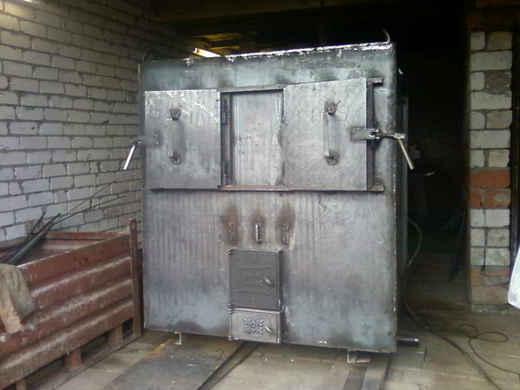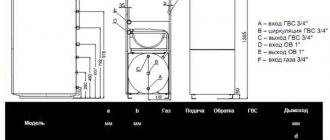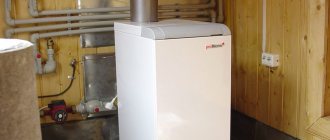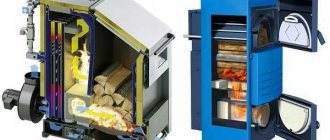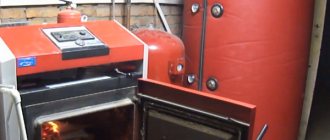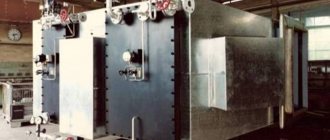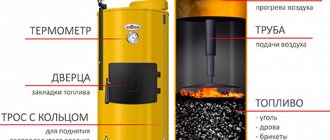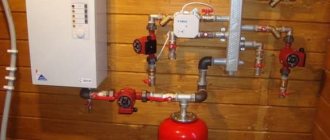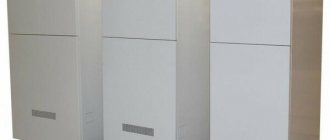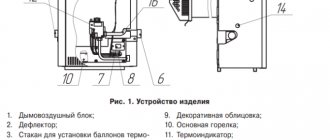Absolutely all owners of private houses want to acquire an installation that will most efficiently use the resources from combustible fuel. But at the same time, you don’t want to significantly overpay for the device itself. Many people decide to make their own, but then another dilemma arises: to rack your brains and build a more complex structure or to make do with a standard one. Let's take a closer look at the attractiveness of buying or assembling a complex unit with your own hands.
Installation device
Reviews of a pyrolysis boiler usually describe the general impression of the device and do not talk at all about its structure. But for those who want to make such a device themselves, this information will be very useful:
1. Loading compartment.
It is into this compartment that fresh air without impurities of low temperature (referred to as “primary”) enters. This is where the stored fuel is burned.
2. Compartment intended for final combustion.
Air at elevated temperatures with impurities enters this compartment (called “secondary”). Directly in this place, all small particles that were not burned in the first compartment are burned. The second compartment is separated from the first by means of a grate (fuel material is placed on it).
3. Heat exchanger compartment.
Here, the air or liquid inside the heat exchanger is heated with heat from the burnt fuel. From this compartment, the high-temperature coolant is distributed throughout the rest of the system and returns here with an already reduced temperature.
4. Exhaust fan for air supply.
For smaller devices, either natural draft is used (which is ineffective) or a fan. For larger and more powerful devices, you should use a smoke exhauster, which will create forced draft inside the device.
5. Adjustment devices for adjusting the power of the device.
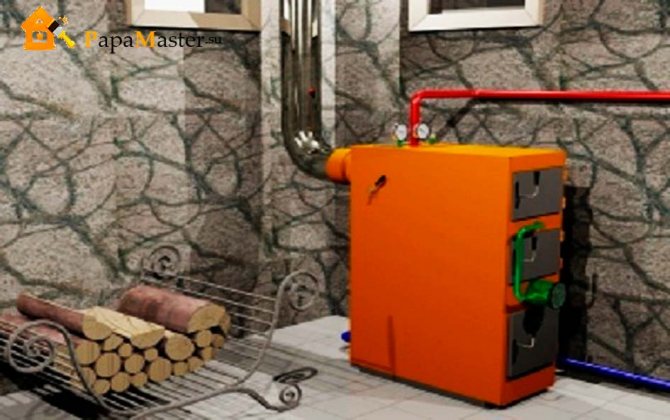
pyrolysis boiler

pyrolysis boiler in the boiler room
Pyrolysis boilers. Work, features of operation.
Pyrolysis boilers
, and quite deservedly, along with other solid fuel heating devices, they have confidently occupied their niche in the field of heating our living space.
Just a few years ago, pyrolysis boilers were nothing more than something fashionable, unusual, a foreign device with surprisingly attractive properties, desirable but so unknown that it was even scary to touch it. Sharing their impressions of pyrolysis boilers, many cited the example of the ancient ancestor of these solid fuel devices, which has already become history - tractors with a gas generator engine, conquerors of the fields of the 30s of the last century. There were, of course, more successful and significant examples of the application of this principle of obtaining thermal energy, but they are not so imprinted in people’s memory and are known only in a narrower circle of heating engineers and amateur boiler builders. At the moment, a large number of various products in this direction are appearing on the market, advertisements are full of mass offers from both already known giants of pyrolysis combustion, and a large number of copied devices, especially those brands that are only virtually present on our market. Since, due to inaccessibility due to the lack of official supplies and certification in our country, a large number of thermal units of the category pyrolysis boilers exist for us and are available only on the Internet. Of course, it is difficult in our time to come up with a completely new and unique design for pyrolysis boilers, and, perhaps, a lot has already been invented in principle. Therefore, many craftsmen who are not accustomed to following the simple path want to “comprehend the incomprehensible” and at home create or copy the most popular and high-tech pyrolysis boilers
, adding to their unique and almost ideal design a piece of their ingenuity, creative and inquisitive mind. And sometimes from this symbiosis something completely new and interesting is born, fresh and non-trivial solutions are found in the execution of certain components and parts, from which these pyrolysis boilers become original and almost original works of technical thought in heating engineering. The most important thing is that in this selfless work and desire to achieve one’s goal, sometimes a truth is born that is worthy of the closest attention and deep respect. At this point in time, pyrolysis boilers are boldly conquering an increasingly wider field of fuel diversity; they, like true solid fuel devourers, can operate on almost all types of fuel, although sometimes they can be structurally different from each other beyond recognition. Of course, traditionally a pyrolysis boiler is a thermal unit for obtaining energy from burning wood, but this has no longer become an axiom, and most likely has lost the properties of the truth. A large number of developers of long-burning boilers initially chose coal and charcoal, since, due to their geographical location, there are regions where firewood is not an affordable fuel, but at the same time, coal is the main popular and optimal in price and quality.
Long-burning coal boilers also burn fuel as efficiently as possible, decomposing it at high temperatures, and thus also use pyrolysis combustion. Of course, the appearance of boilers in this category differs from the classic look of pyrolysis boilers, but this design feature depends only on the type of fuel. It was first developed and implemented in Hungary under the Carborobot brand. All this was successfully picked up and further developed in the south of Western Siberia in the coal Mecca of the Russian state. We also cannot discount pellet boilers, which are undoubtedly long-burning boilers and, as a rule, use pyrolysis combustion of fuel, but due to the high cost of pellets at a distance from Moscow and St. Petersburg and Kaliningrad, they have not yet become widespread in all territories . In terms of their performance, ease of use, and the ability to achieve long periods of time without additional fuel loading, these pyrolysis boilers can be compared with gas boilers running on mains natural gas.
Many people are interested in the question: how do pyrolysis boilers behave during operation? In this article I would like to focus on classic pyrolysis boilers, which use wood as fuel in their work, in the form of logs and lumps of different sizes and humidity. For the third heating season and the third calendar year, I have been operating a pyrolysis boiler of my own production with a thermal capacity of 110 kilowatts. This solid fuel boiler was manufactured by me during the summer-autumn period of 2010 and was put into operation on November 25, 2010. Heated premises with a total area of about 800 m2 are located in four separate buildings, interconnected by heating mains located above the ground and insulated with mineral wool. These heating mains have been in use since 2004, are wrapped in sheet metal, and have not been repaired or maintained since then. The length of the heating mains is about 60 meters, made of steel pipes with a diameter of 57 mm. The nature of the premises varies from residential to industrial repair boxes with large gates.
Why was the choice made in the direction of a pyrolysis boiler? The choice was guided by several conditions: the first is the availability of fuel, our coal is of very low quality, the price for it is high, everything is connected with the “active” gasification of our city, we still have five years to wait, but the decision should have been made three years ago. Electricity was not considered as a cost inefficiency at all. According to calculations, liquid fuel was also not cheap, and its prices are rising. What remains is “Siberian firewood”, of which there is still plenty of any quality, the price is quite reasonable and has been stable for several years.
Next, it was necessary to make a choice of the type of wood-burning boiler, here again I had to read numerous reviews about wood-burning boilers, both factory-made and about analogues and boilers of original designs made by individual craftsmen. A lot of consultations, advice and suggestions, all this made me pay close attention to pyrolysis boilers
, according to all theories, opinions, there can only be a device of such power and with the best quality and efficiency of fuel combustion...
Of course, there are many opponents of this; in general, a large number of heating engineers do not believe in this magical pyrolysis, considering this type of boiler to be very picky about the quality of fuel, and, undoubtedly, suffering from an unreasonably high price. The price is really not small, and therefore the decision was made to make a pyrolysis boiler with a thermal power of 110 kilowatts... Not without good people... And this is Anatoly Dovgal. I am sincerely grateful to him both as the creator of the STS pyrolysis boilers, and simply as a sincere, intelligent and kind person for his enormous assistance in the design and production of my brainchild. Thus, through joint efforts, my pyrolysis boiler was born, which works, warming us in the cold, and serves faithfully for the benefit of me and my loved ones... I would like to summarize the two-year operation of the pyrolysis boiler, talk about the features of operation and some of the subtleties of manufacturing pyrolysis boilers . If you have any questions, ask them on the forum pages about pyrolysis boilers
, and together we will discuss and solve common problems of individual boiler construction.
So, two years of many positive impressions. There are also negative aspects, but first things first. After the first start with supercharging, I immediately realized that the problem of proper sealing and tightness of the doors is a real problem that must be solved seriously if the boiler is in any way in contact with the living space. Initially, I made the entire front part of the boiler removable, as a safety net for solving any emergency issues in the maintenance and ongoing repairs of my pyrolysis boiler. In particular, I was afraid for the nozzle, since I was going to burn with large firewood, and even damp, and loading it carefully all the time was a little problematic. There were no problems here and this is undoubtedly a big plus, but smoke constantly oozed out of this large door when the boiler was heating up, the metal warped, and almost immediately after the boiler was started, there was an exhaust ventilation above the loading door. The problem was partially eliminated, but I decided to close the front of the water jacket and brought this idea to life the following summer. But I left the ventilation, because when heating with raw wood you have to load it with hot wood (this means that 1/4 - 1/3 of the unburned fuel in the boiler and at this moment I load the boiler to full), and smoke cannot be avoided.
The second problem is condensation; the heat exchanger was made a little too big for our entire heating system, but this is better than making a boiler with insufficient thermal power. The reason is this: over time, the efficiency of the heat exchanger decreases due to internal deposits in the boiler and the surfaces in the chimneys simply become clogged, which means heat transfer decreases, in addition, I have a three-pass heat exchanger and there are turbulators in each pass, which during maintenance can be completely pulled out and thereby reduce the thermal power of the heat exchanger. The first winter was relatively warm, so the boiler operates at minimum power, and pyrolysis boilers
they don’t like this, and this is where the problem of condensation arose, I made a drain valve from the lower pocket of the chimney, the third passage of the heat exchanger was constantly clogged with greasy carbon deposits, as a result I simply removed the turbulators from it, it became a little better. Spring has come, I tried to burn off the large soot inside with old tires and the black smoke is not working with my pyrolysis machine with such a volume of soot. I tried to heat it with sawdust, I also got a problem: the sawdust, without burning, flies into the heat exchanger, where it is deposited there along with condensate and this mess clogs everything to capacity and the heat exchanger needs to be serviced frequently... In general, this is also not a very good option. Only at the end of the second season this fall I installed the system mixing water from the supply to the return, and solved this problem: the boiler is hot, the required temperature enters the system, the control was left manual, although I purchased both a controller and an actuator, in my case it turned out that while the brain from the three-way valve is in the box. Additionally, I installed a drain valve from the bottom door of the heat exchanger to check for condensate there.
The third nuance about pyrolysis boilers
: After the first season of operation, I seriously thought about installing a smoke exhauster.
I already wrote on the forum about pyrolysis boilers
that this innovation in the design of my stake brought many positive aspects, etc. For various reasons, I made this decision: the first is to reduce smoke during loading, which is important for heating boilers, especially when loading fuel, but also at the time of acceleration of the boiler at elevated modes, that is, when the boiler reaches operating coolant temperatures from a cold heating system . But here, and almost immediately from the beginning of the heating season, a negative feature appeared on my pyrolysis boiler. I'll tell you about everything in order.
When installing a smoke exhauster on my solid fuel tank, I had to use a little brainstorming and develop a project that was as concise as possible to fit this device into the design of this CO. Try to do everything in such a way as to simplify this work as much as possible, and make minimal changes to the already installed and working piping and, in parallel with these conditions, leave the opportunity, if necessary, for easy and accessible maintenance of the smoke exhaust unit. Of course, we had to work a little, and this unit was born with two dampers, a snail and a smoke exhauster, and a removable unit so that, if necessary, preventive work was carried out here. The second reason why a smoke exhauster was installed is, according to the theory, that the smoke exhaust system works noticeably more economically than an inflatable one due to the fact that excess pressure is not created in the loading chamber, and thus the breakthrough of smoke and pyro-gases through the main door seals is significantly reduced. All this leads, accordingly, to a reduction in heat loss and thereby to an increase in the efficiency of the boiler itself. And even with excess air in the loading chamber, the fuel overheats and the automatic control of the boiler is somewhat more unstable. The brand of smoke exhauster was chosen based on numerous recommendations from manufacturers of pyrolysis boilers; this device is widely used by boiler manufacturers in Germany, the Czech Republic, Poland and Ukraine. A well-known smoke removal fan produced by Ebm-Papst (EBM PAPST) Germany, model R2E210-AA34-05, also recommended by official dealers in Yekaterinburg, with a capacity of about 480 m3 per hour, which should be enough for my 110 kW pyrolysis boiler. I would have taken a little extra, but it was the most productive smoke extractor in this line. Here is a photo of the smoke exhaust unit
So what?.. And the fact that this device is extremely sensitive to condensation and resin deposits, maybe this is how it should be, and in ideal conditions this smoke exhauster would work happily ever after, it’s not for nothing that the developers of pyrolysis boilers carefully calculate heat exchangers, carry out testing before the new model gets into the hands of users. Well, in general, my smoke exhauster was successfully tortured by me during one heating season and at the beginning of this season it was disconnected from the electrical power supply and perhaps soon it will be removed and simply replaced with a flat plug. The fact that resinous deposits formed on its blades is not even half the problem; when an additional boost fan was turned on, smoke burst through it, it overheated, went into protection, that is, it turned off, by itself, even in normal conditions, it always had a motor it was very hot, and even the bearing on which the shaft rotated dried out and creaked. I disassembled it three times during the season, soaked the bearing or bushings with machine oil, I don’t know exactly, I didn’t get to them completely, I just put the oil in there with a syringe. It unwinded and started working again. Inside there is an impeller that prevents the motor itself from overheating, it protects the motor from smoke breakthrough, and so it is made of metal, about 0.1-0.2 mm, all loosened and almost completely deteriorated during this time. In general, the “high-tech German” could not withstand the difficult Siberian operating conditions.
Let's dwell a little more on the topic of the types of fuel that I used in my solid fuel. What and how do pyrolysis boilers consume. As noted and described in the operating manuals of many boilers of this type and especially foreign brands, it is that the fuel that pyrolysis boilers consume with especially high quality and high efficiency, or rather firewood, must have a moisture content of no more than 20%, or be two years old drying under a canopy. Here, of course, one can agree with these recommendations, but only in terms of the fact that it is with this fuel that pyrolysis boilers will produce an efficiency equal to or about 90%. Well, for a simple user of this heating device, many questions arise, and sometimes insurmountable problems, such as how to calculate humidity, where to store this firewood for the deepest and highest quality drying, but what if, like me, I have a boiler of 110 kilowatts and a fuel consumption of about 1 m3 per day on average, then I should have a fuel storage capacity of 300-400 m3, and even with selective fuel sampling.
All this looks complicated at first glance, but in fact pyrolysis boilers
made correctly and from normal manufacturers, they eat both more moist fuel and completely damp lumps from the forest, you just need to add fuel to the firebox correctly and on time.
And just for heating, and without special skill, a little dried firewood is enough, and it burns perfectly, there are no obvious or particularly striking differences (in terms of burning time) from completely dry firewood. There is a dependence on the quality of the firewood, or rather on the wood itself. Let's say we heat with dry fir and dry birch (I'm talking about Siberian contrasts in fuel) or oak, acacia and aspen. Of course, firewood from the densest varieties will burn longer, and in terms of burning time per load of fuel they will surpass lighter firewood, but it is unlikely that they will have a significant difference in the efficiency of the pyrolysis boiler. On dry wood (as opposed to wet wood), as a rule, the temperature of the flue gases is lower, due to the fact that burning dry wood requires less oxygen and, accordingly, less air pressure into the combustion area and in this case the boiler efficiency indicators will be especially high. Although in practice, there are no significant differences in the duration of combustion under the same conditions, dry firewood and, say, birch logs fresh from the forest, thrown on a sufficient amount of unburnt fuel. But starting a burnt-out boiler on logs is simply unrealistic. Anyone who says that any pyrolysis boiler
works equally on both dry and raw fuel is, at the very least, disingenuous, and to be honest, simply deceiving. It is possible to heat for a long time on damp chocks, but this requires practical experience. Almost any user can heat a pyrolysis boiler with dry wood, without paying much attention to the amount of fuel in the loading chamber.
About sawdust... A classic pyrolysis boiler with supercharging or a smoke exhauster cannot be heated with sawdust alone as efficiently as with wood. The sawdust, without burning out, flies out through the pipe and settles in the heat exchanger, in general there are only problems. You can, of course, put a bag or bucket of sawdust on a hot boiler, just like when burning wet wood, in this case they will burn normally without negative consequences. I tried to throw tires from the wheels into the firebox of the pyrolyzer, it doesn’t work, the smoke is black, the neighbors are unhappy, additional deposits are deposited in the heat exchanger, there are significantly more minuses than pluses. There is only one conclusion: pyrolysis boilers efficiently and happily eat wood in any form and any moisture content, but dried wood, even if not according to European standards, is preferable and most digestible for them. Yes, once they brought me, under the guise of dried firewood, dried wood that had lain in a puddle all autumn. In winter, everything froze, it looks like dry wood, but in reality it’s not a fountain at all, so just firewood from the roots is much better than the fuel of this special preparation... I unloaded a lot of different kinds of comments on this matter to this fuel supplier (he was the one who paid me that way , must be).
At the moment, my pyrolysis boiler is left with only a boost fan. I will post photos of the disassembled smoke exhauster later, as soon as I physically remove it from the boiler design, otherwise winter has arrived -25C -35C and it is not yet possible to stop the boiler to install a plug. Yes, fuel consumption at an outside air temperature of -35 in my pyrolysis boiler is approximately 1.3 -1.4 m3 per day, which is clearly reflected in the “super insulation” of the production premises with large and loose gates. The fuel is, as before, logs of birch, cedar and fir from the forest with a mixture of dry firewood. If you have questions, go to our forum and ask questions, links are above
To be continued….
Operating principle of the device
To understand how true the reviews about the pyrolysis boiler are, you need to find out on what principle the device generally works:
1. At the first stage, fuel is loaded into the required compartment, the door to it is tightly closed, and the forced draft device is turned on.
2. Since there is not enough oxygen in this compartment and the temperature is maintained very high, the fuel begins to slowly char instead of burning quickly. As a result, the same pyrolysis (wood gas) begins to be released from the material.
3. Next, the products released during charring are lowered under the grate on which the fuel is stored (grid).
4. At this point, already heated air (called “secondary”) is mixed with them, which burns small volatile particles.
5. The heat generated during this process rises to the fuel and maintains the temperature required to char it.

pyrolysis boiler design diagram
READ ON THE TOPIC:
How to draw up and implement a wiring diagram for a heating boiler in a private cottage.
Popular Bosch boiler models
The Bosch Solid fuel boiler belongs to the current latest generation, therefore it contains all the available innovations in its design. The combustion chamber design has significantly increased the efficiency of heat distribution. So now the boiler has become smaller, and it will heat better. The efficiency was also increased to 85-87%, which is very good for solid fuel models.

The spacious firebox allows you to load enough fuel so that you don’t have to get up in the middle of the night and add fuel. The steel body has undergone additional hardening, so it can easily withstand high temperatures and direct fire for a long period of time.
Bosch long-burning solid fuel boilers receive special attention. This variety practically displaces standard models from the market. The chamber of the unit is designed in such a way that the access of oxygen, which is necessary to maintain the combustion process, is limited. As a result, the fuel, in a sense, simply smolders or sinteres.
As a result of this reaction, gas is released, which will subsequently be burned to produce additional thermal energy. And the fuel itself, due to prolonged exposure to high temperatures, burns much better, gives off more heat and leaves less solid residue.
The efficiency factor exceeds 90%, and environmental safety increases. But the most important thing is that the unit can operate for up to 72 hours from one load of coal. Now you don’t have to constantly visit the boiler room to check the remaining fuel in the firebox.
Operating principle
Of course, if you know physics and chemistry well, then you won’t have to talk long about the principle of operation, but for others you need to remind it. The fact is that when burning wood in a conventional wood stove, the fuel burns throughout its entire volume, releasing a significant amount of heat, most of which... flies out into the chimney.
But pyrolysis boilers, reviews of which indicate exactly the same thing, are based on “high” combustion. In this case, only the top layer of firewood burns, and the lower layer is exposed to high temperatures in the absence of oxygen. Under such conditions, carbon monoxide begins to be released (flammable, by the way), and the firewood partially turns into coal.
